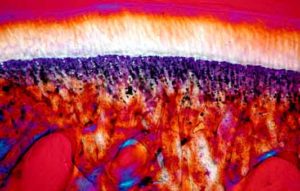
Cartilage articulaire © Inserm/Chappard, Daniel
Researchers from Inserm and Université de Strasbourg at Unit 1260 Regenerative Nanomedicine have developed an implant which, when applied like a wound dressing, regenerates cartilage in the event of major joint lesions and incipient osteoarthritis.
Osteoarthritis – described as destruction of the cartilage affecting the various joint structures, including the bone and synovial tissue that lines the inside of the joints – represents a genuine public health issue.
Depending on the clinical diagnosis, various therapeutic options are possible – ranging from microtransplant to joint replacement.
Nevertheless, these procedures are all invasive, potentially painful, limited in efficacy and not without side effects.
In reality, apart from joint replacement, current treatment strategies are limited to temporary cartilage repair and pain relief.
Treatments mainly involve the injection of anti-inflammatories as well as hyaluronic acid to improve joint viscosity.
Stem cells can also be used, particularly because they secrete molecules able to control the inflammation.
What Ms. Benkirane-Jessel’s team has developed is an innovative osteoarticular implant technique, able to reconstitute a damaged joint and whose application can be likened to that of wound dressings.
“The implant we’ve developed is intended for two cases in particular: major cartilage lesions and incipient osteoarthritis.” she explains.
These dressings comprise two layers. The first – which acts as a support (reminiscent of everyday wound dressings) – is a membrane comprised of polymer nanofibers and supplied with small vesicles containing growth factors in quantities similar to those secreted by our own cells.
It is these cells that – by differentiating into chondrocytes (cells that form the cartilage) – will regenerate the joint cartilage.
The scientists envision a promising future for their “cartilage dressing”
In addition to the shoulder and knee joints the cartilage dressing could also be used for the temporomandibular joint that connects the jawbone to the skull.
The research team has already conducted studies on cartilage lesions in small and large animals (mice, rats, sheep and goats), which are highly suitable models with cartilage comparable with that of humans.
The objective is to launch a study in humans with a small cohort of 15 patients.
For more information
Nature communications
Preclinical safety study of a combined therapeutic bone wound dressing for osteoarticular regeneration
Link…
Inserm
Link…
MDN
This post is also available in:
 Italian
Italian


